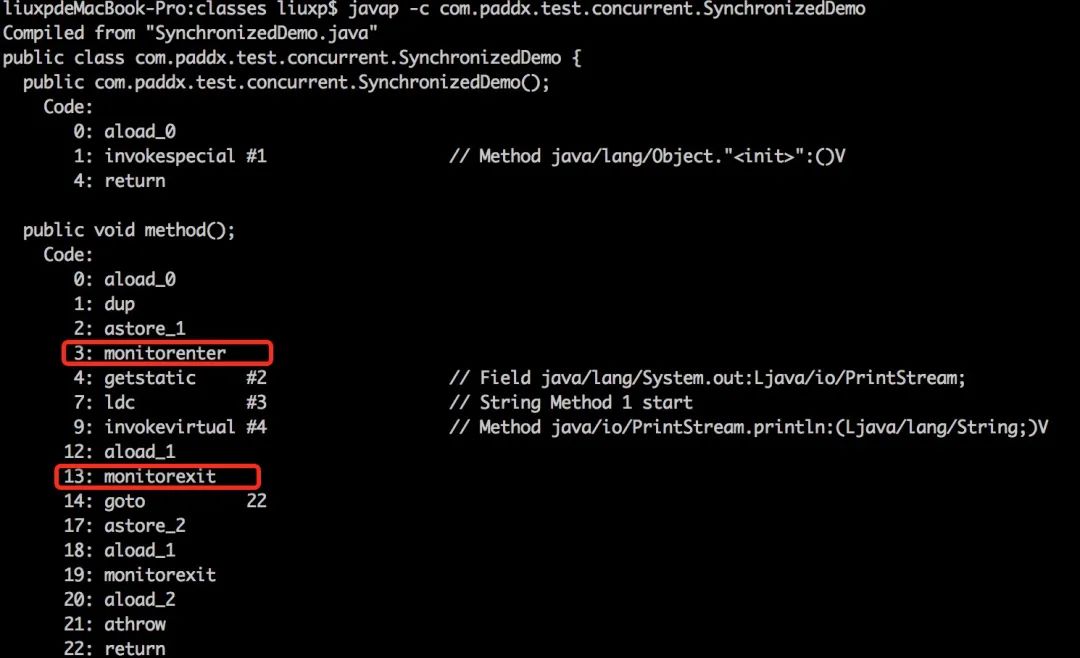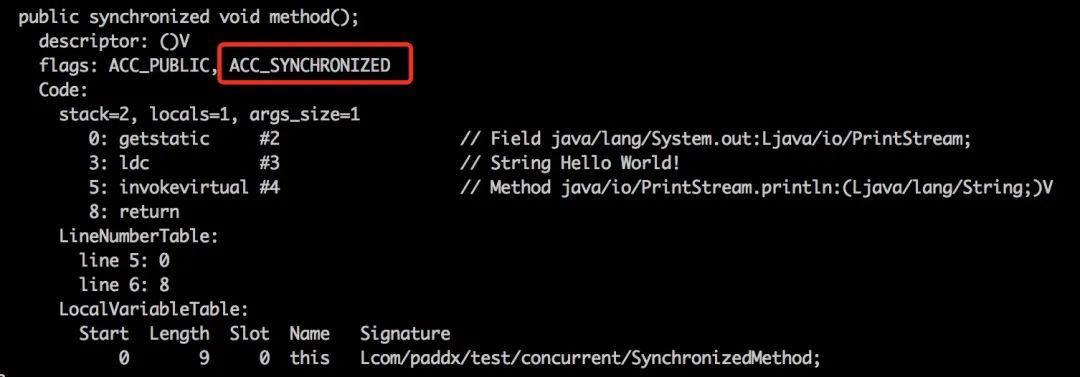【68期】面试官:对并发熟悉吗?说说Synchronized及实现原理
阅读本文大概需要 7 分钟。
来自:www.cnblogs.com/paddix/p/5367116.html
一、Synchronized的基本使用
确保线程互斥的访问同步代码
保证共享变量的修改能够及时可见
有效解决重排序问题。
修饰普通方法
修饰静态方法
修饰代码块
1、没有同步的情况:
package com.paddx.test.concurrent;
public class SynchronizedTest {
public void method1(){
System.out.println("Method 1 start");
try {
System.out.println("Method 1 execute");
Thread.sleep(3000);
} catch (InterruptedException e) {
e.printStackTrace();
}
System.out.println("Method 1 end");
}
public void method2(){
System.out.println("Method 2 start");
try {
System.out.println("Method 2 execute");
Thread.sleep(1000);
} catch (InterruptedException e) {
e.printStackTrace();
}
System.out.println("Method 2 end");
}
public static void main(String[] args) {
final SynchronizedTest test = new SynchronizedTest();
new Thread(new Runnable() {
@Override
public void run() {
test.method1();
}
}).start();
new Thread(new Runnable() {
@Override
public void run() {
test.method2();
}
}).start();
}
}
Method 1 start
Method 1 execute
Method 2 start
Method 2 execute
Method 2 end
Method 1 end
2、对普通方法同步:
package com.paddx.test.concurrent;
public class SynchronizedTest {
public synchronized void method1(){
System.out.println("Method 1 start");
try {
System.out.println("Method 1 execute");
Thread.sleep(3000);
} catch (InterruptedException e) {
e.printStackTrace();
}
System.out.println("Method 1 end");
}
public synchronized void method2(){
System.out.println("Method 2 start");
try {
System.out.println("Method 2 execute");
Thread.sleep(1000);
} catch (InterruptedException e) {
e.printStackTrace();
}
System.out.println("Method 2 end");
}
public static void main(String[] args) {
final SynchronizedTest test = new SynchronizedTest();
new Thread(new Runnable() {
@Override
public void run() {
test.method1();
}
}).start();
new Thread(new Runnable() {
@Override
public void run() {
test.method2();
}
}).start();
}
}
Method 1 start
Method 1 execute
Method 1 end
Method 2 start
Method 2 execute
Method 2 end
3、静态方法(类)同步
package com.paddx.test.concurrent;
public class SynchronizedTest {
public static synchronized void method1(){
System.out.println("Method 1 start");
try {
System.out.println("Method 1 execute");
Thread.sleep(3000);
} catch (InterruptedException e) {
e.printStackTrace();
}
System.out.println("Method 1 end");
}
public static synchronized void method2(){
System.out.println("Method 2 start");
try {
System.out.println("Method 2 execute");
Thread.sleep(1000);
} catch (InterruptedException e) {
e.printStackTrace();
}
System.out.println("Method 2 end");
}
public static void main(String[] args) {
final SynchronizedTest test = new SynchronizedTest();
final SynchronizedTest test2 = new SynchronizedTest();
new Thread(new Runnable() {
@Override
public void run() {
test.method1();
}
}).start();
new Thread(new Runnable() {
@Override
public void run() {
test2.method2();
}
}).start();
}
}
Method 1 start
Method 1 execute
Method 1 end
Method 2 start
Method 2 execute
Method 2 end
4、代码块同步
package com.paddx.test.concurrent;
public class SynchronizedTest {
public void method1(){
System.out.println("Method 1 start");
try {
synchronized (this) {
System.out.println("Method 1 execute");
Thread.sleep(3000);
}
} catch (InterruptedException e) {
e.printStackTrace();
}
System.out.println("Method 1 end");
}
public void method2(){
System.out.println("Method 2 start");
try {
synchronized (this) {
System.out.println("Method 2 execute");
Thread.sleep(1000);
}
} catch (InterruptedException e) {
e.printStackTrace();
}
System.out.println("Method 2 end");
}
public static void main(String[] args) {
final SynchronizedTest test = new SynchronizedTest();
new Thread(new Runnable() {
@Override
public void run() {
test.method1();
}
}).start();
new Thread(new Runnable() {
@Override
public void run() {
test.method2();
}
}).start();
}
}
Method 1 start
Method 1 execute
Method 2 start
Method 1 end
Method 2 execute
Method 2 end
二、Synchronized 原理
package com.paddx.test.concurrent;
public class SynchronizedDemo {
public void method() {
synchronized (this) {
System.out.println("Method 1 start");
}
}
}

Each object is associated with a monitor. A monitor is locked if and only if it has an owner. The thread that executes monitorenter attempts to gain ownership of the monitor associated with objectref, as follows:
If the entry count of the monitor associated with objectref is zero, the thread enters the monitor and sets its entry count to one. The thread is then the owner of the monitor.
If the thread already owns the monitor associated with objectref, it reenters the monitor, incrementing its entry count.
If another thread already owns the monitor associated with objectref, the thread blocks until the monitor's entry count is zero, then tries again to gain ownership.
如果monitor的进入数为0,则该线程进入monitor,然后将进入数设置为1,该线程即为monitor的所有者。
如果线程已经占有该monitor,只是重新进入,则进入monitor的进入数加1.
如果其他线程已经占用了monitor,则该线程进入阻塞状态,直到monitor的进入数为0,再重新尝试获取monitor的所有权。
The thread that executes monitorexit must be the owner of the monitor associated with the instance referenced by objectref.
The thread decrements the entry count of the monitor associated with objectref. If as a result the value of the entry count is zero, the thread exits the monitor and is no longer its owner. Other threads that are blocking to enter the monitor are allowed to attempt to do so.
package com.paddx.test.concurrent;
public class SynchronizedMethod {
public synchronized void method() {
System.out.println("Hello World!");
}
}

三、运行结果解释
1、代码段2结果:
2、代码段3结果:
3、代码段4结果:
四 总结
推荐阅读:
【67期】谈谈ConcurrentHashMap是如何保证线程安全的?
【66期】Java容器面试题:谈谈你对 HashMap 的理解
微信扫描二维码,关注我的公众号
朕已阅 

